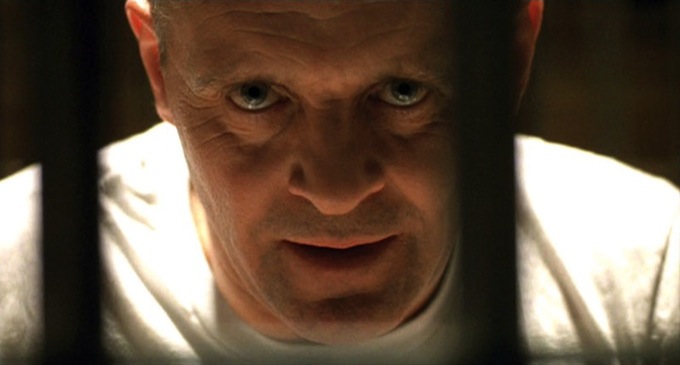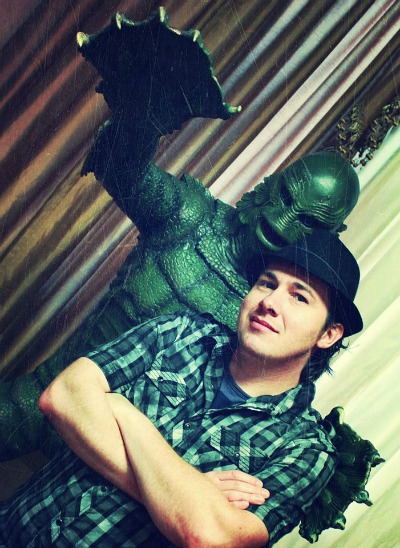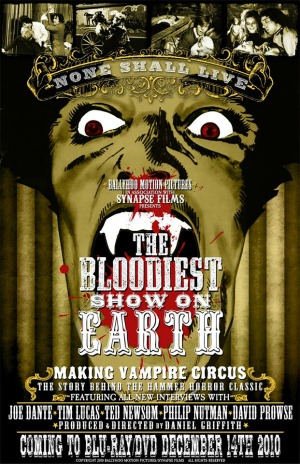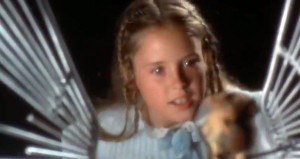by Melanie Crew 
Managing Editor
Get horrified, literary-style this weekend at the 25th Annual World Horror Convention, this year presented by the Horror Writers Association (HWA), haunting Thursday-Sunday May 7-10 at the Atlanta Marriott Marquis! Guests of Honor include legendary bestselling horror author and Marietta local, John Farris; author Kami Garcia (BEAUTIFUL CREATURES); author Christopher Golden; author Charlaine Harris (TRUE BLOOD); author Lisa Tuttle; and Godzilla artist extraordinaire Bob Eggleton, as well as toastmaster Jonathan Maberry and over 150 more writers, editors, filmmakers, publishers, and artists! This year’s World Horror Society’s 2015 Grand Master has been awarded to William F. Nolan, co-author of the novel LOGAN’S RUN, and it’ll be presented with awards for the year’s best in horror fiction Saturday night at the HWA’s Bram Stoker Awards Banquet!
World Horror Con is held in a different location every year, so we think it’s pretty spooktacular that the 25th anniversary con is back in the Monster Kid Capital of the USA. The 1995 and 1999 WHCs were also in Atlanta.
Here are our 10 scariest retro reasons to get downtown.
1) 25th ANNUAL WHC CREEPY COSTUME BALL! Kool Kat Shane Morton, a.k.a. ghost host with the most, Professor Morte and the Silver Scream Spook Show will have you shakin’ in your boots during the Creepy Costume Ball, Friday, May 8! Slither on down for this spooky spectacle which will have you monster mashin’ it up with DJ Extreme Gene and more at the creepiest party of the year! $100 cash prize for best costume, $50 for second place and a free Bram Stoker Awards banquet ticket for third. Party begins at 8:30pm and will rattle your bones through 12:30am!
2) MASS AUTHOR SIGNING! Come one, come all (free and open to the public) to the Mass Author Signing on Friday, which will be bookin’ it from 6:30-8pm! This is an event you won’t want to miss, because you’ll get the chance to catch more than 100 of your favorite horror/spec-lit/weird fiction (and more!) authors, including John Farris, local legendary author and all the other Guests of Honor; Grand Master William F. Nolan; Jack Ketchum, Lifetime Achievement Award recipient and author of such novels as THE GIRL NEXT DOOR; renowned SF/F/H editor Ellen Datlow; New York Times bestselling splatterpunk pioneer and bizarro author John Skipp; Weston Ochse, author of SEAL TEAM 666, which is being developed into a major motion picture starring Dwayne “The Rock” Johnson; Shirley Jackson Award-winning author Nathan  Ballingrud, Scott Nicolay, author of ANA KAI TANGATA, Rue Morgue magazine’s Best Fiction Collection of 2014; many Bram Stoker Award-winning and nominated authors such as Yvonne Navarro, Usman T. Malik, Damien Angelica Walters and Stephen Graham-Jones; our very own wickedly weird kool kitten, ATLRetro publisher Anya Martin; and we kid you not – about 100 more! Atlanta’s Eagle Eye Books is the official bookseller of the WHC, and will be located in the Dealers Room, so stop by and pick up books by your favorite attending author to sign this weekend!
Ballingrud, Scott Nicolay, author of ANA KAI TANGATA, Rue Morgue magazine’s Best Fiction Collection of 2014; many Bram Stoker Award-winning and nominated authors such as Yvonne Navarro, Usman T. Malik, Damien Angelica Walters and Stephen Graham-Jones; our very own wickedly weird kool kitten, ATLRetro publisher Anya Martin; and we kid you not – about 100 more! Atlanta’s Eagle Eye Books is the official bookseller of the WHC, and will be located in the Dealers Room, so stop by and pick up books by your favorite attending author to sign this weekend!
3) THE WEIRD SOUTH. Dig deep into horror’s heritage in Southern Gothic literature, with dark panels galore! On Friday, May 8, you won’t want to miss Voices of the Mountains: Manly Wade Wellman and Karl Edward Wagner at 9 pm, exploring the two pioneers of Southern Horror. The A Good Horror Isn’t Hard to Find: The Dark Side of Flannery O’Connor and Southern Gothic Lit panel gets grotesque Saturday, May 9, at noon!
4) FANGTASTIC FILM! With the support of Atlanta’s own Buried Alive Film Festival (Nov 21-22, 2015) and the Tabloid Witch Film Festival, this year’s film program will spotlight some of the most exciting short and feature films created by Georgia and Southern filmmakers, as well as will showcase recent works by other attending professionals and exciting shorts from around the world. Freaky Friday includes Kool Kat Daniel Griffith of Ballyhoo Motion Pictures discussing his recent documentary endeavors surrounding Jeff Burr’s FROM A WHISPER TO A SCREAM (1987), with exclusive clips from the documentary and giveaways, during The Night(s) Indie-Horror Came to Georgia: An Hour With Daniel Griffith on Friday at 2pm! Get brutal and exploited during a screening of Kool Kat James Bickert’s throwback to ‘60s/’70s exploitation films, DEAR GOD! NO! (2011) is a bloody ruckus at 3pm, with an introduction by Prof. Morte! And stick around for the Filmmakers Lounge at 5pm, where you’ll get to witness film shop talk and learn the fun parts of making horror films! Sinister Saturday brings you a screening of Jason Brock’s THE ACKERMONSTER CHRONICLES (2013), revisiting the life and times of mega-fan Forrest J. Ackerman at 9am (includes a  Q&A with filmmaker and William F. Nolan)! Spend an hour with “Fun Boy” Michael Massee (THE CROW) at 11 am! Get sinister during Skipp’s Saturday Sinema Funtime featuring screenings of John Skipp and Andrew Kasch’s AN HONEST MISSTAKE (2014), Izzy Lee’s POSTPARTUM (2015) and Gigi Saul Guerrero’s EL GIGANTE (2015), beginning at noon! At 1pm, the Buried Alive Film Festival and Kool Kat Blake Myers, present Ryan Lieske’s ABED (2011), based on the Elizabeth Massie story and produced by Atlanta’s own late Philip Nutman (WET WORK, Fangoria), followed by their screening of Kool Kat Eddie Ray’s SATANIC PANIC 2: BATTLE OF THE BANDS (2014) at 2pm. And finally, the Buried Alive Film Festival presents Its Bloody Best, a block of the best shorts screened at past Buried Alive Film Festivals, at 3pm! And stick around for the Filmmakers Lounge where talking shop never gets dull, at 5pm!
Q&A with filmmaker and William F. Nolan)! Spend an hour with “Fun Boy” Michael Massee (THE CROW) at 11 am! Get sinister during Skipp’s Saturday Sinema Funtime featuring screenings of John Skipp and Andrew Kasch’s AN HONEST MISSTAKE (2014), Izzy Lee’s POSTPARTUM (2015) and Gigi Saul Guerrero’s EL GIGANTE (2015), beginning at noon! At 1pm, the Buried Alive Film Festival and Kool Kat Blake Myers, present Ryan Lieske’s ABED (2011), based on the Elizabeth Massie story and produced by Atlanta’s own late Philip Nutman (WET WORK, Fangoria), followed by their screening of Kool Kat Eddie Ray’s SATANIC PANIC 2: BATTLE OF THE BANDS (2014) at 2pm. And finally, the Buried Alive Film Festival presents Its Bloody Best, a block of the best shorts screened at past Buried Alive Film Festivals, at 3pm! And stick around for the Filmmakers Lounge where talking shop never gets dull, at 5pm!
5) MULTI-CULTURAL WORLD HORROR. What’s more fitting when exposing the diversity in the dark underbelly of spec-lit and horror than doing so in the city that was the center of the Civil Rights Movement? Catch Different Visions: African-American Spec-Lit from Afro-Futurism to Beloved on Friday, at 1pm, and get a peek through the lens of the African-American experience from slavery to the Civil Rights Movement to the first black president! On Saturday, May 9, you won’t want to miss Pushing the Diaspora Darkly: Horror from Multicultural Perspectives at 1pm, which explores diversity and an emerging global view of spec-lit and horror as it moves into the 21st century with a new generation of writers from different cultural backgrounds.
6) WHC LIFETIME ACHIEVMENT AWARD RECIPIENTS. This year’s Lifetime Achievement Award recipients are Tanith Lee, author of more than 90 novels across the entire spectrum of speculative literature; and Jack Ketchum, author of 32 books to date, with five of his novels making their way to the big screen [The Lost, The Girl Next Door, Red, Offspring and The Woman]. Celebrate Tanith Lee’s achievement during Dancing With Darkness: A Tribute to HWA Lifetime Achievment Award Winner Tanith Lee on Friday, at 10am! And you won’t want to miss the HWA Lifetime Achievement Award Winner Interview: Jack Ketchum at 2pm, Friday!
 7) H.P. LOVECRAFT IN THE 21st CENTURY. Learn about Lovecraft’s legacy in modern horror fiction, which has been cemented for more than half a century in his Cthulhu Mythos and his exploration of cosmic, existential horror. More recently, the tentacles of Lovecraft’s more troubling legacy—as a voice for some of the last century’s most vile expressions of racism and xenophobia—have found their way into the center of the discussion of his work, so creep on down, Friday at 3pm for the H.P. Lovecraft in the 21st Century: The Problematic Legacy of the Great Old One of Horror and the Weird panel!
7) H.P. LOVECRAFT IN THE 21st CENTURY. Learn about Lovecraft’s legacy in modern horror fiction, which has been cemented for more than half a century in his Cthulhu Mythos and his exploration of cosmic, existential horror. More recently, the tentacles of Lovecraft’s more troubling legacy—as a voice for some of the last century’s most vile expressions of racism and xenophobia—have found their way into the center of the discussion of his work, so creep on down, Friday at 3pm for the H.P. Lovecraft in the 21st Century: The Problematic Legacy of the Great Old One of Horror and the Weird panel!
8) THE STEPHEN KING HOUR. Are you Stephen King’s biggest fan? If so, you won’t want to miss The Stephen King Hour at 5pm on Friday, and catch the experts discuss the most important horror writer of this generation! (One lucky contest winner will get the chance to sit on this horrorific panel!)
9) READINGS, READINGS AND MORE READINGS! What’s better than reading the works of this century’s wickedly weird and catastrophically creepy writers, who have reaped what our horror forefathers of yore, sowed many murderous moons ago? Why, getting the chance to experience the horror spewing from their own lips! Friday, May 8, brings you readings by Charlaine Harris, William F. Nolan (co-author of Logan’s Run and more), Kami Garcia, Usman T. Malik, Joe McKinney, Nathan Ballingrud (North American Lake Monsters), Scott Nicolay (Ana Kai Tangata) and more! Saturday, May 9, brings you readings by Jack Ketchum; Christopher Golden, James A. Moore, Lisa Tuttle, Jonathan Maberry, Weston Ochse, Yvonne Navarro, Damien Angelica Walters, Molly Tanzer (A Pretty Mouth, Vermilion and more) and Jesse Bullington [The Sad Tale of the Brothers Grossbart, The Enterprise of Death and more]!
10) HISTORIC HORROR: FACT & FICTION! The written word has a way of bringing reality to life and vice-versa! Don’t miss out on a special presentation by Dacre Stoker, Bram Stoker’s great grand-nephew at 11am during the Bram Stoker / Dracula Travel Guide New Discoveries 118 Years Later event, exploring his specialized travel guide surrounding Bram’s most famous novel, Dracula. Dacre’s one-hour PowerPoint presentation includes stunning photos of sites associated with Bram’s life in Dublin, his holidays in Whitby, Cruden Bay Scotland, Count Dracula and Vlad Dracula sites in Romania. At 2pm get monstrous during the Atlanta Radio Theatre Company’s presentation of “The Passion of Frankenstein” by Thomas E. Fuller. This classic radio theatre retelling of the classic story by Mary Shelley is sure to thrill and chill! And, what are the limits of horror’s human side? Catch the Horror’s Human Side: There Are NO Limits, Or Are There panel at 5pm, which explores Joyce Carol Oates’ take on horror fiction and realistic fiction, whether some subjects are too horrific to be horror, and what’s the line between realist literature and horror lit?
Years Later event, exploring his specialized travel guide surrounding Bram’s most famous novel, Dracula. Dacre’s one-hour PowerPoint presentation includes stunning photos of sites associated with Bram’s life in Dublin, his holidays in Whitby, Cruden Bay Scotland, Count Dracula and Vlad Dracula sites in Romania. At 2pm get monstrous during the Atlanta Radio Theatre Company’s presentation of “The Passion of Frankenstein” by Thomas E. Fuller. This classic radio theatre retelling of the classic story by Mary Shelley is sure to thrill and chill! And, what are the limits of horror’s human side? Catch the Horror’s Human Side: There Are NO Limits, Or Are There panel at 5pm, which explores Joyce Carol Oates’ take on horror fiction and realistic fiction, whether some subjects are too horrific to be horror, and what’s the line between realist literature and horror lit?
World Horror Con main hours are Thur. May 7 from 6 p.m. to midnight.; Fri. May 8 from 9 a.m. to midnight; Sat. May 9 from 9 a.m. to midnight; and Sun. May 10 from 9 a.m. to 2 p.m., with parties going late into the night on Friday and Saturday. For more info, visit www.whc2015.org.






































